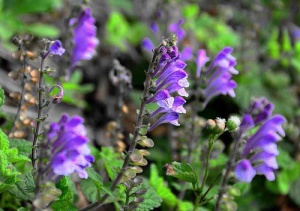Skullcap
Contents
Common Names, Habitat & Description
Skullcap is commonly known by many other names including; scullcap, hoodwort, blue pimpernel, quaker bonnet, helmet flower, mad dog, madweed, huang quin, baikal skullcap, etc. Skullcap is a perennial herb, native to North America. Its caplike appearance of the outer whorl of its small blue or purple flowers, coincide with the name of Skullcap. Its stalks are slender, yet heavily branched and range in heights of 2-4 feet, the flowers are known to bloom anywhere from July to September.
Constituents & Actions
Flavonoids such as scutellarin, iridoids (catalpol), volatile oils/waxes and tannins are present in this herb.
Skullcap is most popularly used as a nervine tonic, anti-spasmotic (prevents or relieves spasms), hypotensive (reduces blood pressure) and anti-inflammatory.
Indications
As a nervine, Skullcap relaxes various states of nervious tension, while revitalizing the nervous system. It has been specifically used is the treatment of seizures, schizophrenia, hysteria and epilepsy. It may be used in all exhausted or depressed conditions.
Since Skullcap is also know for it's anti-inflammatory capabilities, it is also helpful in the treatment of arthritic conditions.
Skullcap is beneficial in the relief of pre-menstrual tension and insomnia. It is often combined with such herbs as valerian, passion flower and black cohosh for such symptoms.
Preparation & Dosing
To make an infusion, pour one cup of boiling water over 1-2 teaspoons full of the dried herb, leave alone to infuse for 10-15 minutes, drink three times per day. The tincture may be used 3x's daily in the dose of 2-4ml.
Side-effects
High doses of Skullcap may cause giddiness, stupor, mental confusion, muscular twitching or irregular heartbeat. Injections of this herb may possibly cause liver damage. Consult with your doctor before using if pregnant or breast feeding.
